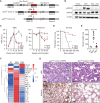Jak2V617F Reversible Activation Shows Its Essential Requirement in Myeloproliferative Neoplasms
- PMID: 38230747
- PMCID: PMC11061606
- DOI: 10.1158/2159-8290.CD-22-0952
Jak2V617F Reversible Activation Shows Its Essential Requirement in Myeloproliferative Neoplasms
Abstract
Gain-of-function mutations activating JAK/STAT signaling are seen in the majority of patients with myeloproliferative neoplasms (MPN), most commonly JAK2V617F. Although clinically approved JAK inhibitors improve symptoms and outcomes in MPNs, remissions are rare, and mutant allele burden does not substantively change with chronic therapy. We hypothesized this is due to limitations of current JAK inhibitors to potently and specifically abrogate mutant JAK2 signaling. We therefore developed a conditionally inducible mouse model allowing for sequential activation, and then inactivation, of Jak2V617F from its endogenous locus using a combined Dre-rox/Cre-lox dual-recombinase system. Jak2V617F deletion abrogates MPN features, induces depletion of mutant-specific hematopoietic stem/progenitor cells, and extends overall survival to an extent not observed with pharmacologic JAK inhibition, including when cooccurring with somatic Tet2 loss. Our data suggest JAK2V617F represents the best therapeutic target in MPNs and demonstrate the therapeutic relevance of a dual-recombinase system to assess mutant-specific oncogenic dependencies in vivo.
Significance: Current JAK inhibitors to treat myeloproliferative neoplasms are ineffective at eradicating mutant cells. We developed an endogenously expressed Jak2V617F dual-recombinase knock-in/knock-out model to investigate Jak2V617F oncogenic reversion in vivo. Jak2V617F deletion abrogates MPN features and depletes disease-sustaining MPN stem cells, suggesting improved Jak2V617F targeting offers the potential for greater therapeutic efficacy. See related commentary by Celik and Challen, p. 701. This article is featured in Selected Articles from This Issue, p. 695.
©2024 The Authors; Published by the American Association for Cancer Research.
Figures




References
-
- Levine RL, Pardanani A, Tefferi A, Gilliland DG. Role of JAK2 in the pathogenesis and therapy of myeloproliferative disorders. Nat Rev Cancer 2007;7:673–83. - PubMed
Publication types
MeSH terms
Substances
Grants and funding
- R33 CA267219/CA/NCI NIH HHS/United States
- F99 CA284253/CA/NCI NIH HHS/United States
- K08 CA241371/CA/NCI NIH HHS/United States
- P01 CA108671/CA/NCI NIH HHS/United States
- P50 CA254838/CA/NCI NIH HHS/United States
- K08 CA215317/CA/NCI NIH HHS/United States
- P30 CA008748/CA/NCI NIH HHS/United States
- R01 HL157387/HL/NHLBI NIH HHS/United States
- R01 HL145283/HL/NHLBI NIH HHS/United States
- K08 HL169905/HL/NHLBI NIH HHS/United States
- T32 CA009207/CA/NCI NIH HHS/United States
- UG3 NS132139/NS/NINDS NIH HHS/United States
- RM1 HG011014/HG/NHGRI NIH HHS/United States
- K99 CA248460/CA/NCI NIH HHS/United States
- F99 CA274656/CA/NCI NIH HHS/United States
- R35 CA197594/CA/NCI NIH HHS/United States
- K08 CA230172/CA/NCI NIH HHS/United States
- K08 CA267058/CA/NCI NIH HHS/United States
- R00 CA248460/CA/NCI NIH HHS/United States
- R37 CA286857/CA/NCI NIH HHS/United States
- T32 GM007739/GM/NIGMS NIH HHS/United States
LinkOut - more resources
Full Text Sources
Miscellaneous

